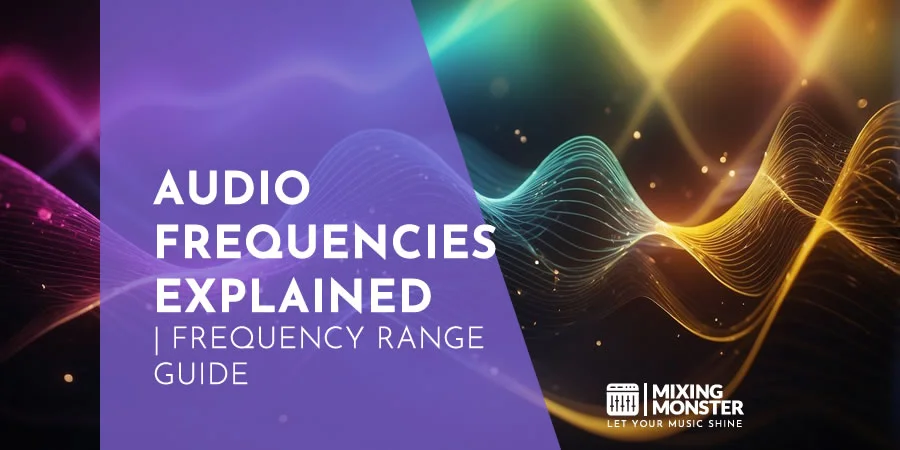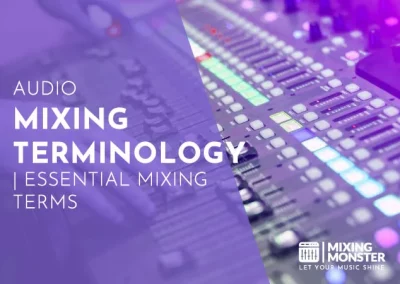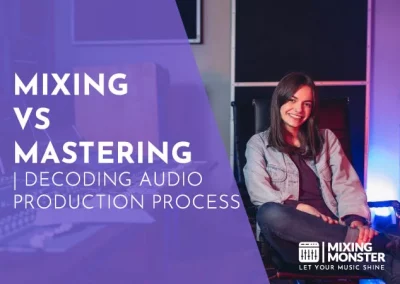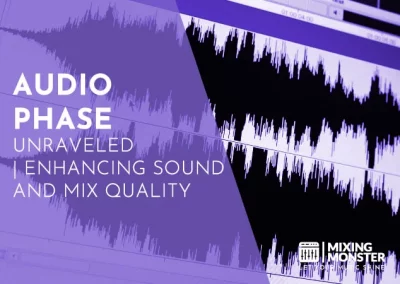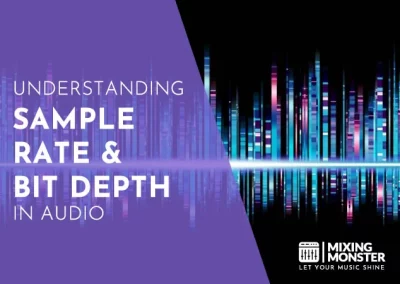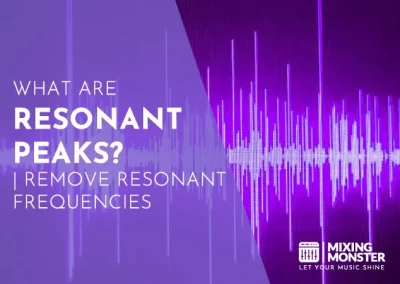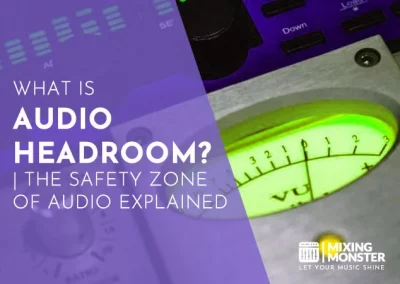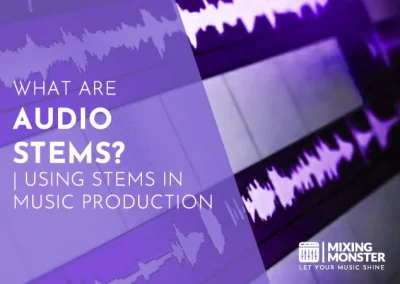Home > Blog > Mixing > Mixing Insights
Disclosure: Some of the links below are affiliate links, meaning that at no additional cost to you, we will receive a commission if you click through and make a purchase. Read our full affiliate disclosure here.
Audio frequencies play a crucial role in how we perceive the world around us, resonating through the music we love, the shows we binge-watch, and the conversations we engage in daily. By understanding the landscape of sound waves, individuals and professionals unlock an array of possibilities within audio production and sound analysis.
The audio frequency spectrum refers to the range of sound frequencies that can be heard by the human ear, typically spanning from 20 Hz to 20,000 Hz. This spectrum is the foundation for all sound designs, music production, and audio engineering. Different frequency ranges possess distinct characteristics and are managed individually in mixing to achieve a clean, balanced sound. Recognizing and manipulating these frequencies is essential for resolving common audio issues and maintaining tonal balance across various genres.
This article offers many insights into audio frequencies, from recognizing pitch to mastering complex mixing techniques. As you dive deeper, you’ll uncover the rich textures that make up the soundscape of your favorite tunes and grasp the advanced tools that audio professionals utilize to sculpt the perfect audio experience.
KEY TAKEAWAYS:
- Audio frequencies, ranging from 20 Hz to 20,000 Hz, are vital to our auditory experience.
- Understanding the audio frequency spectrum is fundamental to sound design and music production.
- Exploring audio frequencies deepens one’s ability to manipulate and analyze sound.
Table Of Contents
1. The Audio Frequency Spectrum Explained
2. Characteristics Of Different Frequency Ranges
3. Handling Audio Frequencies In Mixing
4. Common Frequency-Related Issues In Mixing
5. Tonal Balance Across Different Genres
6. Advanced Techniques For Modifying Frequency Areas
7. Tools And Technology For Audio Frequency Analysis
8. Summarizing Audio Frequencies In Music Production
9. FAQ

1. The Audio Frequency Spectrum Explained
Exploring the audio frequency spectrum is essential for understanding how sound is split into different pitches and tones you hear. It is a range where various frequencies play distinct roles, each critical in shaping the overall listening experience.
Defining The Frequency Range: From Bass To Treble
Frequency range refers to the spectrum of all possible frequencies of sound that the human ear can detect, typically ranging from 20 Hz to 20,000 Hz. The lower end of this range contains the bass frequencies. These deep, low-pitched sounds start from 20 Hz up to around 60 Hz and extend to 250 Hz. The presence of bass gives the music a sense of power and foundation.
On the opposite end lies the treble, which covers the higher frequencies from approximately 2,500 Hz to 20,000 Hz. Treble frequencies are where you perceive the sharpness or clarity of sounds, such as the chirping of birds or the ring of cymbals.
The Role Of Midrange Frequencies In Music Production
Midrange frequencies bridge bass and treble, typically ranging from 250 Hz to 2,500 Hz. This section is crucial for most musical instruments and the human voice, as it carries most of the content that defines tone and character.
Balancing the midrange is essential when producing music, as it dramatically affects the lyrics’ intelligibility and the overall sound’s warmth.
Understanding frequency bands within the audio frequency spectrum allows you to manipulate and appreciate the nuances of sound, whether you’re enjoying music or engaged in audio production.
2. Characteristics Of Different Frequency Ranges
Each frequency range in audio production and music has distinct characteristics that contribute to the overall sound experience. By understanding how these ranges interact, you can shape the tonal balance of your music.
Low-End Frequencies: Warmth And Fullness
The low-end frequencies provide the foundation of a music track, often described as its “warmth” and “fullness.” This includes the deep bass that you feel as much as you hear. The bass range generally creates a sense of power and solidity in music.
Mid-Range Frequencies: The Heart Of Clarity And Presence
Your listening experience is predominantly shaped by mid-range frequencies, consisting of the lower midrange, midrange, and upper midrange. This is where the “clarity” and “presence” of instruments and vocals lie. It’s critical for delivering the intelligibility of lyrics and the harmonic structure of musical instruments.
High-End Frequencies: Brightness And Sparkle
High-end frequencies, or the treble range, bring “brightness” and “sparkle” to a mix. Here, the crispness of high-hats and the sheen on vocal sibilance are found, giving a sense of detail and airiness.
Frequency Range Characteristics Table
| Frequency Range | Includes | Characteristics | Role In Music |
|---|---|---|---|
| Low-End Frequencies | Sub-bass, Bass | Warm, full, powerful | Provide depth and impact, foundation of rhythm |
| Lower Midrange | Often overlaps with upper bass | Can be muddy or boomy | Richness and body to lower harmonics |
| Midrange | Central part of the spectrum | Clear, present, full of detail | Critical for vocal clarity, carries most instrumental sounds |
| Upper Midrange | Higher notes of instruments | Pronounced, can be piercing | Helps in defining texture and edge |
| High-End Frequencies | Treble | Bright, airy, sparkling | Adds definition and space, crucial for high-frequency detail |
3. Handling Audio Frequencies In Mixing
Effective manipulation of audio frequencies during the mixing process can enhance the clarity and quality of your music. In this section, you will learn how to identify and manage different frequency bands to shape your mix, using subtractive and additive equalization techniques to achieve the best possible sound.
Identifying And Isolating Audio Frequency Bands
To create a balanced mix, you first must identify and isolate the different audio frequency bands in your audio material. These bands range from sub-bass through mid-range to high frequencies. Attention to these bands’ frequency response and volume can help you make informed decisions when applying equalization (EQ).
The Art Of Subtractive EQ: When To Cut Audio Frequencies
Subtractive EQ involves intentionally cutting specific frequencies to reduce muddiness or to allow other instruments to stand out. This approach cleans up the mix and reduces the risk of loudness issues. As a rule of thumb, use subtractive EQ to remove frequencies that detract from the sound before considering boosting.
The Impact Of Additive EQ: When To Boost Audio Frequencies
Conversely, additive EQ focuses on boosting specific frequencies to increase the presence or loudness of an audio element. Apply an equalization boost with caution and only when necessary to enhance the pleasing aspects of the sound or to ensure instruments sit well together in the mix.
Techniques For EQing Resonant Frequencies And Harsh Sounds
Notch filtering helps you target and reduce these problematic areas when faced with resonant frequencies or harsh sounds. Careful adjustment with a narrow Q-factor can mitigate such issues without significantly affecting your mix’s overall sensitivity and tonal balance. Always listen critically and make incremental changes to avoid over-EQing.
4. Common Frequency-Related Issues In Mixing
Managing frequency ranges effectively in audio mixing is vital to achieving a polished sound. Awareness of specific frequency-related issues can greatly impact the final mix, allowing you to maintain balance and clarity across all elements.
Muddiness In The Low-End And How To Avoid It
Muddiness often plagues the sub-bass and lower frequency ranges, resulting primarily from excess energy in the 200Hz area. This can cause your mix to sound mud-laden and undefined.
To counteract muddiness, consider applying a high-pass filter on non-bass instruments to remove unneeded low-frequency content and utilizing EQ cuts around the problematic frequencies on your bass elements.
Properly managing the low end ensures that your track carries the necessary weight without compromising definition.
Harshness In The High-End: Finding The Balance
The high-end of the frequency spectrum, or treble, is home to the clarity and definition of your mix, but too much emphasis can result in harshness.
High frequencies can quickly become fatiguing to the ear when overrepresented. To achieve the optimal balance, it’s crucial to use EQ to attenuate overly prominent high frequencies and occasionally applies de-essing to tame harsh sibilance in vocal tracks.
Dealing With Masking And Ensuring Each Instrument Sits Well In The Mix
Masking occurs when multiple instruments compete for the same frequency space, making it difficult for each instrument to be distinctly heard. To mitigate this, identify frequency overlaps and adjust levels or apply EQ notches to emphasize the key sonic elements of each instrument.
For instance, if your guitar and keyboard are masking each other, find their unique characteristic frequencies and boost them slightly while cutting the competing frequencies to ensure each instrument sits nicely in the mix.

5. Tonal Balance Across Different Genres
Tonal balance is the key to ensuring your music resonates as intended, regardless of genre. Correctly adjusted frequency ranges can make or break a track’s impact.
Genre-Specific Audio Frequency Considerations
Rock:
Expect a powerful, low-end, pronounced midrange, giving the guitars and drums prominence. Achieving tonal balance here means respecting this hierarchy, ensuring bass doesn’t overpower the distinct growl of electric guitars.
Hip-Hop:
Here, you will strongly emphasize deep bass and clear, upfront vocals. The midrange takes a backseat, allowing the low end to drive the rhythm and the highs to ensure vocal clarity.
Classical:
Classical music demands a wide frequency range to accommodate the diverse timbre of orchestral instruments. A balanced midrange is essential, with careful attention to not overshadowing the nuances of strings and woodwinds.
Jazz:
The tonal balance in jazz often highlights a smooth midrange and controlled bass. This genre requires a transparent high-end to bring out the subtle timbre of cymbals and brass instruments.
EDM:
EDM thrives on a heavy bass presence and bright, sparkling highs that allow synths to shine. Mids must be carefully managed to prevent muddiness, ensuring a clean mix where rhythmic elements can punch through.
How To Achieve Genre-Appropriate Tonal Balance
First and foremost, familiarize yourself with equalization (EQ) techniques; this is your primary tool. It’s vital to listen to reference tracks within your genre to understand the desired tonal balance. When you mix and master, compare your tracks against these references and use high-quality monitors or headphones for accurate feedback.
For precision, use a spectrum analyzer to visualize where frequencies may be peaking or dipping. Corrective EQ can then be applied to align your track with the genre’s characteristics. Utilize tools like tonal balance control to achieve the right balance, especially when working across different listening environments.
Remember, achieving the right tonal balance is a blend of technical skill and the artistic intuition you develop by critically listening to music within your target genre.
6. Advanced Techniques For Modifying Frequency Areas
Audio production professionals often seek to sculpt the perfect sound by manipulating different frequency areas. Advanced techniques like Dynamic EQ and Multiband Compression and Saturation and Harmonic Excitement can be employed when standard equalization does not suffice.
These methods allow more precise and creative control over your audio system’s sound.
Dynamic EQ And Multiband Compression Explained
Dynamic EQ is a fusion of standard EQ and a compressor. Unlike traditional EQs that affect the signal at all times, a dynamic EQ applies changes only when certain frequencies exceed a set threshold.
This allows for precise shaping of your audio’s frequencies as it responds to the dynamic range of the signal—boosting or cutting in a fluid, responsive manner.
Dynamic EQs are especially useful when addressing intermittent problems, such as a resonant frequency that only sticks out at certain moments.
What makes dynamic EQ particularly useful is its ability to make real-time adjustments, which means it adjusts the gain of a specified frequency range based on the input signal level—perfect for tackling problematic frequencies without affecting the rest of the spectrum. It’s a valuable tool when mastering because it can deal with the outliers of a mix without the artifacts that static EQ might introduce.
Multiband compression takes a similar yet distinct approach. Picture your audio signal split into multiple bands, each representing a range of frequencies. With multiband compression, you can compress each of these bands independently, allowing for targeted dynamic control. You define how many bands to use and set the compressor’s parameters for each band.
How does this benefit you? Imagine you’re dealing with a bass line that’s too dynamic in the lower frequencies (say, below 120 hertz (Hz)) but well balanced in the upper harmonics—multiband compression allows you to compress just the problematic low end.
Or, if the vocals in your mix are too piercing around 3 kHz during certain phrases, you can set a band to tame those peaks. Multiband compression gives you the granularity to address these issues without tampering with the audio’s other components that don’t require intervention.
Shaping Audio Frequencies With Saturation And Harmonic Excitement
Moving on to saturation, this beloved tool is the subtle art of adding warmth and depth to your tracks. Historically, saturation comes from overdriving analog tape machines or tube amps, leading to a fuller, richer sound.
In the digital realm, saturation plugins emulate this effect, adding harmonics to the fundamental tone, thereby enriching the sound in a controlled manner.
When applied judiciously, saturation can make individual elements of your mix stand out or help an entire mix feel more cohesive. It’s not just about making things louder; it’s about enhancing the texture and body of the sound.
By introducing additional harmonic content, you can alter a track’s perceived loudness and energy without raising the actual level; this is particularly useful for elements that need to cut through a dense mix without overpowering it.
Harmonic excitement, conversely, zeroes in on specific frequencies to enhance clarity or add sparkle. It dynamically generates harmonics based on the input signal, lifting certain aspects of your sound.
This is invaluable for dull tracks requiring more presence or specific elements that could use a splash of brilliance in the upper-frequency spectrum without resorting to broad EQ boosts that could unbalance a mix. Harmonic exciters can breathe life into vocals, add punch to snare drums or bring out the harmonic complexity of stringed instruments.
By using these techniques, you can expect a marked improvement in the quality and definition of your audio projects. The manipulation of audio frequencies is as much an art as it is a science.
With Dynamic EQ, Multiband Compression, Saturation, and Harmonic Excitement, you have a nuanced set of tools for crafting the perfect sonic landscape.
7. Tools And Technology For Audio Frequency Analysis
The right tools can make a significant difference when working with audio frequencies. Specialized technology such as audio spectrum analyzers and EQ plugins greatly enhance your capacity to analyze and adjust frequencies for various applications, from music production to scientific research.
Audio Spectrum Analyzers And Their Use
Audio spectrum analyzers are essential when visualizing different sound signal components. They provide a graphical representation of the audio’s frequency spectrum, allowing you to see frequencies and their amplitudes at a glance.
This visualization can reveal insights into the tonal balance, harmonics, and potential issues with the mix that may not be immediately apparent by ear alone.
For instance, an oscilloscope can help identify phase relationships between different sounds, while a goniometer gives insight into stereo images and balance. The primary applications for these tools include:
- Mixing And Mastering:
To ensure a well-balanced mix that translates well across different playback systems. - Sound Design:
To sculpt and precisely shape sounds, considering their spectral content. - Acoustic Analysis:
Particularly in-room treatment or speaker placement to ascertain how sound behaves in a given space.
EQ Plugins And Their Audio Frequency Analysis Features
EQ plugins serve a dual purpose. They allow you to adjust the frequency content of your audio signal and come with built-in features to analyze frequencies. Graphic equalizers and parametric EQs are the most common types.
While graphic equalizers visually represent frequency bands, parametric EQs provide more precise control over frequency, bandwidth (Q), and gain. Plugins like the Voxengo SPAN also include spectrum analyzing capabilities, allowing you to see changes in the audio spectrum as you adjust, enhancing your understanding of how EQ changes impact the signal.
Use EQ plugins to:
- Enhance Or Diminish Certain Frequencies:
Shape the tonal character of individual tracks or a full mix. - Identify And Resolve Frequency Conflicts:
Spot and address issues where instruments compete for the same frequency space. - Analyze Harmonic Content:
Examine overtones and harmonics that contribute to the perceived sound of an instrument or voice.
Using these tools, you can dissect, understand, and manipulate audio frequencies more accurately to achieve your desired outcomes in any auditory project.
8. Summarizing Audio Frequencies In Music Production
Understanding audio frequencies is critical in music production, as they comprise the backbone of sound that the human ear can perceive.
The range spans from 20 Hz to 20,000 Hz, and within this range, specific frequencies play distinct roles that contribute to the fullness and clarity of musical pieces.
- Sub-Bass (20-60 Hz):
This range includes the lowest bass frequencies, which provide depth and power. - Bass (60-250 Hz):
These frequencies add body and the fundamental notes of rhythm, particularly in modern music. - Low Mids (250-500 Hz):
This region holds the weight of many instruments, defining the richness and warmth of the music. - Midrange (500 Hz-2 kHz):
The midrange is essential for vocal clarity and the intelligibility of musical instruments. - High Mids (2 kHz-4 kHz):
This region can accentuate presence and detail in music, making instruments more distinguishable. - Presence (4 kHz-6 kHz):
Frequencies here ensure that the sibilance and attack of sounds cut through the mix. - Air (6 kHz-20 kHz):
High-end frequencies add a sense of space, airiness, and brightness to a track.
You can achieve a well-rounded mix by attentively shaping and balancing these frequency bands. Remember that every aspect of music production involves understanding the limits of human hearing.
Harnessing this knowledge allows you to sculpt a sonic landscape that translates well across various listening environments and is pleasing to the human ear.
9. FAQ
1) What defines the range of frequencies humans can hear?
Humans typically hear sounds ranging from 20 Hz to 20,000 Hz. This range represents the limits of human hearing, from the lowest bass to the highest, almost inaudible pitches.
2) How do sound frequencies affect human health and well-being?
Frequencies can affect health differently; low-frequency noise may cause discomfort or annoyance, while certain frequencies can induce relaxation or alertness. However, prolonged exposure to extreme volumes or frequencies can be harmful.
3) What is considered the optimal frequency range for high-quality audio playback?
Generally, the optimal frequency range for high-quality audio playback spans from 20 Hz to 20,000 Hz, allowing for full-spectrum sound reproduction that covers the limits of human hearing.
4) How can different audio frequencies be generated for testing purposes?
Different frequencies are generated using audio signal generators or software-based tone generators, where precise frequency levels can be created for analysis or calibration.
5) What are the characteristics of high, mid, and low-frequency ranges in audio?
High frequencies (2 kHz to 20 kHz) account for brightness and clarity, mid frequencies (250 Hz to 2 kHz) carry the fundamental tones of most instruments and vocals, and low frequencies (20 Hz to 250 Hz) provide depth and power.
6) How can one conduct an audio frequency range test effectively?
To conduct an audio frequency range test, use a sound level meter in conjunction with a frequency generator to measure the response of a room or device across the audible spectrum. This ensures the equipment or space is accurately outputting sounds at various frequencies.

